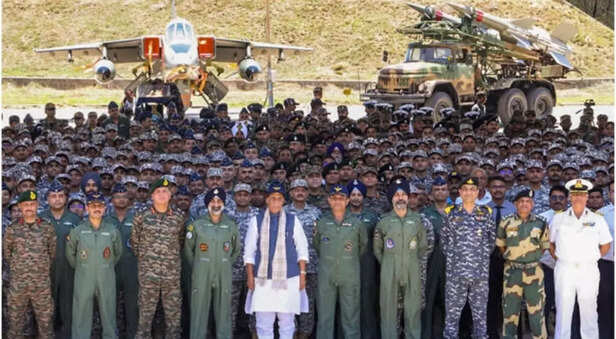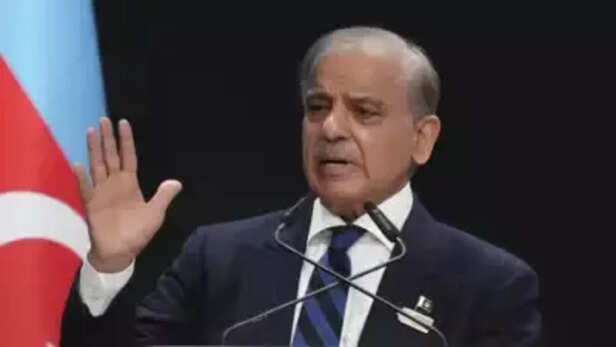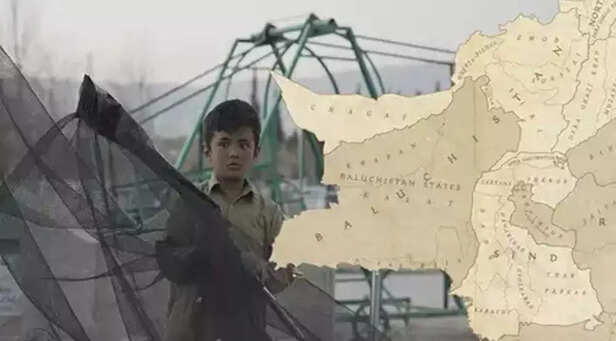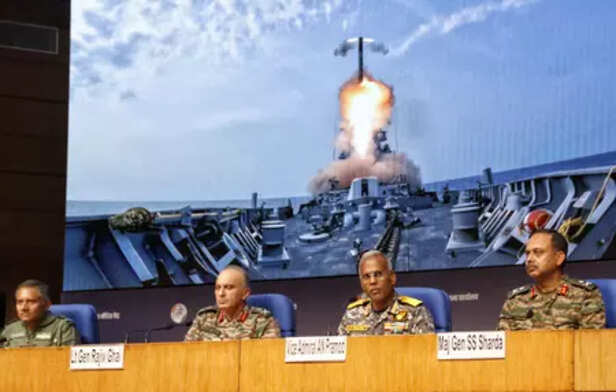This Is A 5th Generation Warfare—Not Pakistan's Centre of Gravity
Ankit Gupta | May 20, 2025, 18:27 IST
Pakistan continues to live in the past, clinging to outdated military concepts such as the "Centre of Gravity"—a term that belongs to the post-World War II playbook, not the hyper-fluid, decentralized conflicts of today.
In today’s geopolitical arena, wars are no longer fought just on borders or battlegrounds. The world has transitioned into 5th Generation Warfare (5GW)—a realm of psychological manipulation, economic strangulation, information control, and cyber dominance. It is a war where your mind, your narrative, your economy, and your perception are the battlefield. Unfortunately, while nations like India have embraced this evolving reality, Pakistan continues to live in the past, clinging to outdated military concepts such as the "Centre of Gravity".
This outdated mindset was recently on display when a Pakistani military spokesperson casually referred to the idea of "Centre of Gravity" as though it were still the defining principle of modern warfare. It was a telling moment. It revealed not only the intellectual stagnation of Pakistan’s strategic community but also how dangerously unaware they are of the shift in global conflict paradigms. Wars are no longer about tanks and trenches; they are about narratives, disruption, denial, and digital decimation.

India, by contrast, is now operating on an entirely different level. Operation Sindoor, for instance, was not just a mission; it was a demonstration. A message. A glimpse into how surgical, precise, and layered India’s military planning has become. It served as a symbolic awakening, a preview of how India can strike with intelligence, without needing to go all out. Sindoor was just the beginning—the real arsenal, both strategic and technological, remains waiting for Pakistan's next misstep.
India’s new warfare strategy doesn’t stop at military strength. The Smart Power Doctrine is a blend of hard military assets, soft cultural influence, and diplomatic precision. India has turned global perception into a weapon. It has leveraged economic credibility, diplomatic restraint, and strategic silence to corner Pakistan in forums like FATF, while making strong inroads into G20 diplomacy, QUAD alliances, and the UN narrative ecosystem.
What makes 5GW brutal is that the enemy ends up destroying itself. Pakistan today is seeing its institutions weaken, its economy spiral, and its people lose faith. This isn’t India’s interference—it’s the result of internal rot. But that rot is accelerated because India no longer needs to wage open war; it only needs to expose truths, enable international scrutiny, and watch the erosion unfold.

India is no longer relying solely on missiles or tanks. Its real arsenal includes psychological operations (PSYOPS), cyber control grids, energy kill-switch capabilities, AI-based threat analysis, and global perception warfare. Pakistan’s problem is it is preparing for a war with tanks; India is preparing for a war of ideas, codes, alliances, and deterrence. And it's already winning.
Pakistan’s diplomatic isolation is not random—it is engineered through India's silent diplomacy and strategic leverage. While Pakistan fails to build sympathy around its Kashmir rhetoric, India has painted it into a global corner by showcasing its role in terror financing and extremism. China, Turkey, and even the U.S. know where their long-term interests lie—and Pakistan isn’t on the list.
Pakistan keeps preparing for a war it doesn’t understand. Meanwhile, India has already won the war of perception, trust, narrative, and deterrence. Pakistan’s people are disillusioned, its economy is gasping, its global standing is sinking, and its enemies are now within. That’s 5GW in action—and India didn’t need to fire a bullet.

While Pakistan burns from within—ethnic tensions in Balochistan, Sindh unrest, inflation, and distrust in the army—India has built internal cohesion through cultural resurgence, economic growth, and nationalistic synergy. This stability allows India to play long-term strategic games while Pakistan remains caught in short-term fire-fighting.
Pakistan is dangerously close to triggering an irreversible response. One more Pulwama, one more proxy misadventure, and the gloves will come off. But this time, India’s retaliation won’t just be cross-border—it will be multi-domain, asymmetric, and globally visible. And Pakistan will be left alone, abandoned by its so-called allies, facing the full force of a smarter, deadlier adversary.

5GW is not about destroying the enemy physically; it’s about destroying their will, their identity, and their coherence. It uses social media, misinformation, economic sanctions, global narratives, and cyber intrusions to break a country down from within. It erodes trust in institutions, causes public confusion, and turns people against their own state. In that sense, India has already achieved something massive—Pakistan is suffering from self-destruction accelerated by its own ignorance.
This warfare does not require a single bullet. It uses memes instead of missiles, lies instead of landmines, influence instead of invasion. While Pakistan's generals still obsess over "strategic depth" and Cold War relics, India is executing AI-powered surveillance, algorithmic propaganda tracking, deep fake detection systems, and narrative control mechanisms—not only within its borders but even inside Pakistan’s digital space. The battlefield has extended to your phones, your newsfeeds, your economy—and India is already inside the system.
Pakistan keeps hoping that Turkey, China, or some Islamic alliance will come to its rescue. But in 5GW, that’s a fallacy. Credibility trumps comradeship. And India, with its measured diplomacy, rising global influence, and restraint, is far more trusted by the world than a crisis-prone, denial-driven Pakistan. No alliance can save you when your own people don’t believe in your story anymore.
Let’s not forget: India is not itching for war—it is preparing for inevitabilities. This is not 1999. This is not even 2016. India’s new security doctrine includes preemptive retaliation, cross-border counter-terror operations, cyber kill-switches, energy grid sabotage capabilities, and digital asset freezes—all coordinated through a deeply integrated civil-military-diplomatic triad.
And should Pakistan repeat another Pulwama or Uri-style mistake, the response will not just be military. It will be multi-domain and asymmetric. It will strike not just where it hurts, but where Pakistan didn’t even know it could be hurt. And this time, there will be no window for diplomatic rescue. No China stepping in to cool things down. No Turkey issuing meaningless statements. No US brokerage. The world has changed. And India, today, has leverage, not dependency.
“The strongest enemy is not the one who attacks you—it is the one who makes you destroy yourself.”
India embraced this reality. Pakistan dismissed it. And history will remember the consequences.
This outdated mindset was recently on display when a Pakistani military spokesperson casually referred to the idea of "Centre of Gravity" as though it were still the defining principle of modern warfare. It was a telling moment. It revealed not only the intellectual stagnation of Pakistan’s strategic community but also how dangerously unaware they are of the shift in global conflict paradigms. Wars are no longer about tanks and trenches; they are about narratives, disruption, denial, and digital decimation.
India's Smart Power Doctrine Is the New Battlefield

Hegemony Overwhelmed
India, by contrast, is now operating on an entirely different level. Operation Sindoor, for instance, was not just a mission; it was a demonstration. A message. A glimpse into how surgical, precise, and layered India’s military planning has become. It served as a symbolic awakening, a preview of how India can strike with intelligence, without needing to go all out. Sindoor was just the beginning—the real arsenal, both strategic and technological, remains waiting for Pakistan's next misstep.
India’s new warfare strategy doesn’t stop at military strength. The Smart Power Doctrine is a blend of hard military assets, soft cultural influence, and diplomatic precision. India has turned global perception into a weapon. It has leveraged economic credibility, diplomatic restraint, and strategic silence to corner Pakistan in forums like FATF, while making strong inroads into G20 diplomacy, QUAD alliances, and the UN narrative ecosystem.
What makes 5GW brutal is that the enemy ends up destroying itself. Pakistan today is seeing its institutions weaken, its economy spiral, and its people lose faith. This isn’t India’s interference—it’s the result of internal rot. But that rot is accelerated because India no longer needs to wage open war; it only needs to expose truths, enable international scrutiny, and watch the erosion unfold.
Global Isolation of Pakistan is Strategic, Not Accidental

Maksad Man
India is no longer relying solely on missiles or tanks. Its real arsenal includes psychological operations (PSYOPS), cyber control grids, energy kill-switch capabilities, AI-based threat analysis, and global perception warfare. Pakistan’s problem is it is preparing for a war with tanks; India is preparing for a war of ideas, codes, alliances, and deterrence. And it's already winning.
Pakistan’s diplomatic isolation is not random—it is engineered through India's silent diplomacy and strategic leverage. While Pakistan fails to build sympathy around its Kashmir rhetoric, India has painted it into a global corner by showcasing its role in terror financing and extremism. China, Turkey, and even the U.S. know where their long-term interests lie—and Pakistan isn’t on the list.
Pakistan keeps preparing for a war it doesn’t understand. Meanwhile, India has already won the war of perception, trust, narrative, and deterrence. Pakistan’s people are disillusioned, its economy is gasping, its global standing is sinking, and its enemies are now within. That’s 5GW in action—and India didn’t need to fire a bullet.
India’s Internal Stability Is Its Greatest Weapon

Balochistan Sets Free
While Pakistan burns from within—ethnic tensions in Balochistan, Sindh unrest, inflation, and distrust in the army—India has built internal cohesion through cultural resurgence, economic growth, and nationalistic synergy. This stability allows India to play long-term strategic games while Pakistan remains caught in short-term fire-fighting.
Pakistan is dangerously close to triggering an irreversible response. One more Pulwama, one more proxy misadventure, and the gloves will come off. But this time, India’s retaliation won’t just be cross-border—it will be multi-domain, asymmetric, and globally visible. And Pakistan will be left alone, abandoned by its so-called allies, facing the full force of a smarter, deadlier adversary.
In 5GW, Alliances Don’t Matter—Credibility Does

Pakistan punished through military and non-military means
( Image credit : IANS )
5GW is not about destroying the enemy physically; it’s about destroying their will, their identity, and their coherence. It uses social media, misinformation, economic sanctions, global narratives, and cyber intrusions to break a country down from within. It erodes trust in institutions, causes public confusion, and turns people against their own state. In that sense, India has already achieved something massive—Pakistan is suffering from self-destruction accelerated by its own ignorance.
This warfare does not require a single bullet. It uses memes instead of missiles, lies instead of landmines, influence instead of invasion. While Pakistan's generals still obsess over "strategic depth" and Cold War relics, India is executing AI-powered surveillance, algorithmic propaganda tracking, deep fake detection systems, and narrative control mechanisms—not only within its borders but even inside Pakistan’s digital space. The battlefield has extended to your phones, your newsfeeds, your economy—and India is already inside the system.
Pakistan keeps hoping that Turkey, China, or some Islamic alliance will come to its rescue. But in 5GW, that’s a fallacy. Credibility trumps comradeship. And India, with its measured diplomacy, rising global influence, and restraint, is far more trusted by the world than a crisis-prone, denial-driven Pakistan. No alliance can save you when your own people don’t believe in your story anymore.
Silence is Calibration
And should Pakistan repeat another Pulwama or Uri-style mistake, the response will not just be military. It will be multi-domain and asymmetric. It will strike not just where it hurts, but where Pakistan didn’t even know it could be hurt. And this time, there will be no window for diplomatic rescue. No China stepping in to cool things down. No Turkey issuing meaningless statements. No US brokerage. The world has changed. And India, today, has leverage, not dependency.
“The strongest enemy is not the one who attacks you—it is the one who makes you destroy yourself.”
India embraced this reality. Pakistan dismissed it. And history will remember the consequences.
